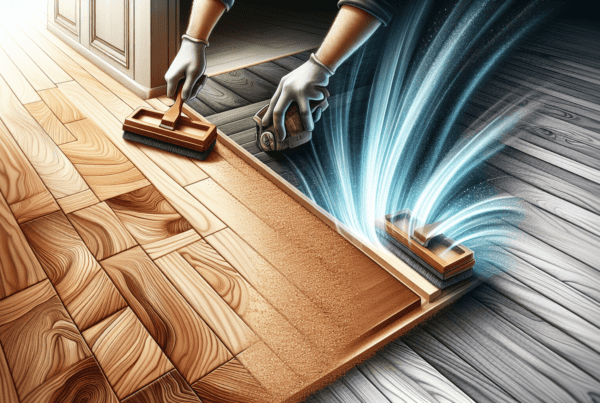As professionals in the field floor refinishing and preservation, we offer our wealth of knowledge and expertise on the subject of floor sanding. Our comprehensive guide, “All About Floor Sanding,” will provide you all the necessary information relating to the intricacies of floor sanding and staining, and a special focus on Wellington Floor Sanding and Staining. With first-hand information from us – the experienced professionals, the guide aims to enhance your understanding and tackle your queries related to the subject matter. Now, let’s get started on this enlightening journey of discovering the art of floor sanding.

This image is property of images.unsplash.com.
Understanding Floor Sanding
Floor sanding is more than a mere household chore. It’s a restoration process, a method to breathe new life into your aging interior. It evokes a sense of warmth, homeliness, and a dash of vintage vibes that radiate off the perfect wooden flooring.
Definition of Floor Sanding
Floor sanding is the process of removing the top surfaces of a wooden floor by sanding down with abrasive materials. This is typically performed to remove the old finish and make the floor smooth for a new finish to be applied.
The Purpose of Floor Sanding
floor sanding is necessary as it revives and rejuvenates wooden floors that have seen better days. Scratches, dents, stains and worn patches are all common signs of aging that can be remedied with a good, thorough floor sanding. Sanding prepares the floor for a new finish, enabling you to change the look and feel of your rooms, making old floors look as good as new.
Types of Floor Sanding Machines
Belt Sanding Machines
Belt sanding machines are powerful pieces of equipment designed for heavy duty sanding. They utilize continuous belts of sandpaper to scrub away the uppermost layer of wood on your floors. Ideal for large flat surfaces, these machines ensure quick and efficient sanding.
Edge Sanding Machines
Edge sanding machines come into play when needing to sand the hard-to-reach areas, like corners and edges. As the name suggests, these machines are perfect for those detailed jobs to ensure a smooth and consistent finish across the entire floor.
Buffing Machines
Buffing machines are used after the sanding process is complete. These machines polish the floors, adding a final touch, and preparing the surface for staining or sealing.

This image is property of images.unsplash.com.
The Floor Sanding Process
Assessing the Floor Condition
The first step of floor sanding involves assessing the condition of the floor. This step helps us understand the amount of work needed and to select the appropriate sanding machines and sandpaper grit.
Choosing the Right Sandpaper Grit
Choosing the right sandpaper grit is vital. The grit of the sandpaper will depend on the floor condition. Coarse grits are necessary for old, worn floors, while fine grits are ideal for fine-tuning and achieving smooth finishes.
The Sanding Procedure
The sanding procedure involves several steps, beginning with the large belt sanding machines for the main area, followed by the edge sanding machines for corners. Once the desired smoothness is achieved, buffing machines are used for polishing.
Safety Measures during Floor Sanding
Safety Equipment
Safety should never be compromised when performing floor sanding. Safety goggles, dust masks, and ear protection are some of the safety equipment needed. It’s essential to wear appropriate clothing and use gloves to prevent injuries.
Handling Sanding Machines
Carry out machine operations correctly and safely. Always turn off the machine when adjusting sandpaper and never leave the machine unattended while it’s running.
Proper Disposal of Dust
The sanding process can create a lot of dust. This waste must be collected and disposed of correctly to prevent health hazards and keep the area clean.

This image is property of images.unsplash.com.
Common Sanding Mistakes to Avoid
Skipping Grits
Moving up grits is like climbing a ladder—you can’t skip steps. Ignoring this progression can lead to scratches and a floor that is not properly smooth.
Not Changing Sandpaper Often Enough
Sandpaper wears out with time. Not changing the sandpaper often can lead to inefficient sanding and will ultimately compromise the finish of your floor.
Failure to Finish Sanding Process
Not completing the sanding process as outlined is another common mistake that can cause an uneven surface and a less than spectacular result.
Benefits of Professional Floor Sanding
Quality of Work
With professional floor sanding services, you are assured of high-quality work. Pros have the training, expertise, and tools to deliver exceptional results.
Efficiency and Time-saving
A professional crew can sand a floor much faster than an amateur, saving you significant time and energy. Plus, you won’t have to deal with the mess.
Expert Advice
Hiring professionals also means you get expert advice on floor maintenance, the best finishes, and long-lasting treatment solutions.
Choosing a Floor Sanding Service
Factors to Consider
The cost, experience, customer reviews, and the quality of service are important factors to consider when choosing a floor sanding service.
Questions to Ask Potential Service Providers
Inquire about their techniques, equipment, guarantees, and whether they have insurance coverage. These questions will help you determine their comprehensive ability to handle your floor.
Floor Sanding versus Floor Polishing
Differences in Procedures
Floor sanding involves removing a layer of the wooden floor to create a new, smooth surface, while floor polishing is simply enhancing the shine of your floors by cleaning and buffing them.
When to Sand and When to Polish
Consider sanding when your floors are worn or damaged. Polish when your floors are still in good condition and you want a quick refresh to make them shine.
Comparing Results
The results of sanding are more dramatic and give your floors a brand new look compared to the subtle shine and refresh that floor polishing provides.
Floor Staining after Sanding
The Purpose of Floor Staining
Staining is done to enhance the natural grain of the wood, allow customization of the floor color, and provide protection to the wood.
Choosing the Right Stain
Consider the type of wood, your color preference, and your décor when choosing a stain.
The Process of Floor Staining
After the floor has been properly sanded and cleaned, the stain is applied. Once it has dried, it’s usually followed by the application of a protective coating.
Maintaining Your Sanded Floor
Cleaning Guidelines
Clean the floors regularly with products recommended for wooden flooring. Avoid products that can cause build-up or damage the finish of the floor.
Preventing and Addressing Damage
Prevent damage by using protective pads under furniture, maintaining a steady indoor humidity and addressing any damage quickly by professional resanding or refinishing.
When to Consider Re-Sanding
Consider re-sanding your floors when they look worn out and refinishing doesn’t bring back their shine. Always consult with an expert before deciding on re-sanding.








2 Comments